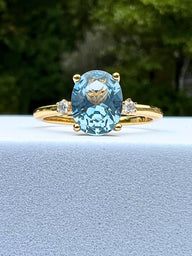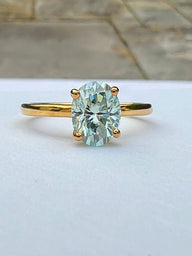FREE SHIPPING | BUY NOW, PAY LATER
Lab-made gemstones, also known as synthetic, simulated, or created gemstones, are rapidly gaining popularity as an alternative to mined gems. While mined gems have been traditionally considered the “real thing,” lab-made gemstones offer several benefits that make them a superior choice in many cases. The three biggest reasons, in our opinion, are:
1. Environmentally Friendly
Lab gemstones offer a more eco-friendly option when compared to mined gems. Mining for natural gems can result in serious environmental damage, such as soil erosion, habitat loss, and water contamination, whereas lab gemstones are crafted inside a carefully regulated environment. Depending on the gemstone, over 20x less water is used, while no communities, habitats, or ecosystems are displaced or disrupted.

2. Cost-Effective
Lab gemstones are much more wallet-friendly than mined gems. Unlike mined gemstones, lab gemstones have no cartel pricing, no overly expensive extracting processes, and often they're domestically (U.S.) produced, reducing transportation costs and carbon footprints. Some lab gemstones, like moissanite, are expensive and time-consuming to produce, taking months, which is reflected in their price. However, when comparing moissanite to a mined diamond, you will likely be much happier with the moissanite price, assuming you like spending less money.

3. Conflict Free
It’s very hard to tell where a mined gemstone truly comes from, and unfortunately, many of the large jewelry businesses want to keep it that way. As an example, rubies coming from Myanmar (formerly Burma) have been banned in the U.S. and many other countries, due to funding a military government that’s been accused of committing genocide, and many human rights violations. To get around sanctions, Burmese rubies generally end up in Thailand, where they’re cut, polished, and sold to jewelry companies around the world. As a result, those rubies won’t be classified as conflict stones, even though they are still funding human rights atrocities. Unfortunately, big jewelry companies know this, but want to keep it this way, as they can tout not selling conflict stones, while also being able to buy them for a cheap price.

Ultimately, lab gemstones present many major advantages that make them far more appealing than mined gemstones. Not only are they arguably more ethical and environmentally sound, but they also are more affordable and can look like an expensive mined gemstone. With that being said, we have no judgment towards those who do decide that a mined stone is for them, but we'd like to allow you to make a more informed decision no matter what type of gemstone you choose to buy!







